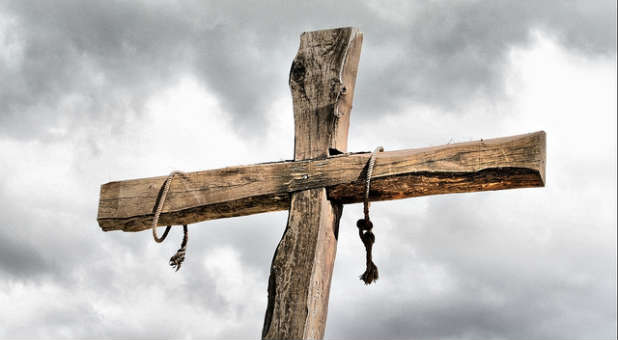
Today’s hymn from Sing Praise is “His cross stands empty in a world grown silent” by the sisters of Stanbrook Abbey (one of several of their hymn in this book). As John commented in his video, Easter Eve forces us to think about what happens to our own bodies after death, and what (if anything) we can say Christ was doing between his death and resurrection. This hymn takes the traditional view that his spirit ‘descended to the dead’ to bring them the good news of salvation and release them from death (using the ancient image of the souls of the dead lying captive beneath the earth while heaven is above it).
All such ideas are of course pictorial images of matters beyond the realm of science and everyday experience. The belief that the souls of the dead live on beyond the decay of their bodies is widespread across many religions and cultures, evidenced (if you wish) by the many people who have seen ghosts or hear the voices of their deceased at a séance, although Christianity has always been wary of such ‘contacts’ (often attributing such manifestations to the deceptions of evil spirits). The Christian view is that we should just have faith that God will one day resurrect with new bodies all who have trusted in him, the resurrection of Christ being sufficient proof for us to hold that belief with confidence.
The empty cross is a symbol of that faith. Although some Christians wear the crucifix or display it on walls, altars or elsewhere, the cross itself without the corpus (body of Christ) is an equally common symbol (probably more common in Protestant churches) and represents the enduring promise that even after the crucifixion has happened, God always has the power to bring its benefits to humankind.
To the Community of Stanbrook Abbey: Dear Sirs,
A friend and I are undertaking a challenge of singing all the hymns in the “Sing Praise” hymn book over the course of the year, and for Saturday April 3rd he has scheduled “His cross stands empty” (no. 70), which was written by the community at Stanbrook Abbey. Unfortunately I cannot get my head around the suggested tune in the book, so I have written another and I thought I ought to let you see it, just for your information.
The rationale behind it is as follows:
(1) Although the words as set out just as poetic stanzas seem to have irregular line-lengths and therefore no particular rhythm, in fact closer inspection reveals that if one hurries over certain groups of words in the first and third lines of each verse, a rhythmic pattern does emerge – and the fact that these hurryings are possible in the same places in the different verses indicates that this feature was probably in the mind of the writer(s). The tune ought to respect this aspect of the words, so as to bring out their rhythm.
(2) The hymn as a whole moves from despondency to hope, and therefore the music ought to bring out this transition too. This can be achieved by setting the tune mournful (i.e. in the minor) for the beginning, and joyful (i.e. in the major) for the end, the transition being on the word “light” in verse 2 line 2. Accordingly the melody needs to hang together and be tuneful in both minor and major modes, so that a transfer can be effected at the crucial point with the minimum of difficulty.
(3) The message is quite simple and unadorned, and the tune ought therefore to be as simple as possible given the above two constraints. So I have written it in three-part harmony (instead of the more usual four-part) with the simplest possible structure and harmonies.
I attach the sheet music, but I am aware that nowadays a lot of people find the sheet music a bit daunting, so I have also recorded myself singing and playing the hymn and have posted it on YouTube at: https://youtu.be/Fi3L58vhvV0 so that you can see it. The music is, of course, copyright as the words are, but I freely give my goodwill for Stanbrook Abbey and its Friends to use the music.
With all good wishes, yours in Christ … .
– – – – –
Dear Mr Hartley, Thank you for this and for the copy of your music for the ‘His cross stands empty’. (I listened to the YouTube link you sent). Thank you, too, for asking about our music and letting us see yours. I am not competent to comment on music, and I don’t know the hymn book ‘Sing Praise’, so am not familiar with the music you refer to.
I attach a copy of the music we use. It is from ‘Stanbrook Abbey Hymnal’, which transposes into 5 line music the chant based music we compose and write on four lines. Certainly the music here is chant, not conventional music. Our music for this text is intended to convey the peace and majesty of Holy Saturday, the quiet dignity of the day, the victory about to be won, with the resurrection imminent. At the same time, there is poignancy in all that has gone before and led to this point. For us here at Stanbrook it is a very moving hymn, its power conveyed through the text and music together. We only sing it once a year – on Holy Saturday.
With every good wish. May your endeavour to sing all the hymns in ‘Sing Praise’ go well and be fruitful.
– – – – –
For the record, the “chant”, although not the tune in the hymn book, did bear a resemblance to it in that there was no particular rhythm (chants of course are intended to be sung in speech-rhythm) and the melody rose and fell in approximately the same general shape – so it may have been material which the tune-writer had when composing.